2.2: Addition, Subtraction, and Scalar Multiplication of Vectors
- Page ID
- 125029
Addition and Subtraction of Vectors
To add or subtract two vectors, add, or subtract their corresponding components.
To ADD the vectors \(\vec{u}\) and \(\vec{v}\)
Solution
To ADD the vectors \(\vec{u}\) and \(\vec{v}\), begin by writing each in component form.

\(\vec{u}=\langle-3,-8\rangle \text { and } \vec{v}=\langle 6,3\rangle\)
ADD their corresponding components
\(\vec{u}+\vec{v}=\langle-3+6,-8+3\rangle=\langle 3,-5\rangle\)
So, \(\vec{u}+\vec{v}=\langle 3,-5\rangle\)
Now, graph this sum.
- Start at the origin.
- Since the horizontal component is 3, move 3 units to the right.
- Since the vertical component is −5 , move 5 units downward.
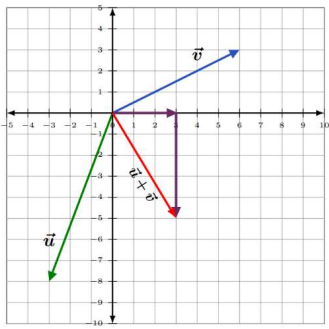
The addition of two vectors \(\vec{u}\) and \(\vec{v}\) can be demonstrated by placing the tail of one vector at the head of the other. Then connect the tail of \(\vec{u}\) to the head of \(\vec{v}\).
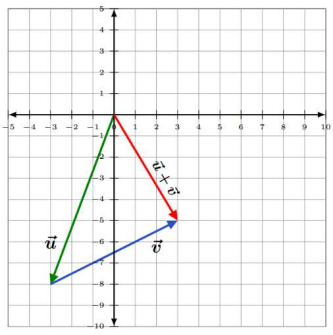
To SUBTRACT the vector \(\vec{u}\) from the vector \(\vec{v}\)
Solution
To SUBTRACT the vector \(\vec{u}\) from the vector \(\vec{v}\), begin by writing each in component form.
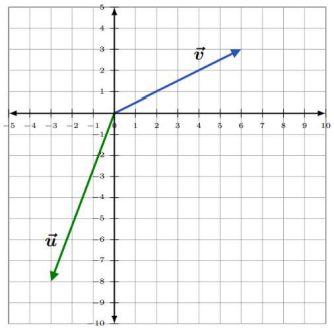
\(\vec{u}=\langle-3,-8\rangle\) and \(\vec{v}=\langle 6,3\rangle\)
SUBTRACT the components of \(\vec{u}\) from the corresponding components of \(\vec{v}\)
\(\vec{v}-\vec{u}=\langle 6-(-3), 3-(-8)\rangle=\langle 6+3,3+8\rangle=\langle 9,11\rangle\)
So, \(\vec{v}-\vec{u}=\langle 9,11\rangle\)
Now, graph this sum.
- Start at the origin.
- Since the horizontal component is 9, move 9 units to the right.
- Since the vertical component is 11, move 11 units upward.
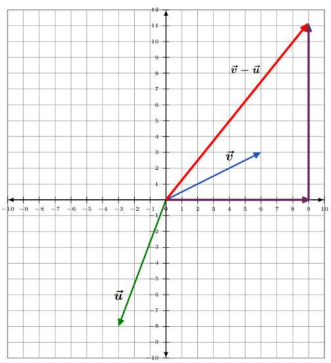
Scalars
In contrast to a vector, and having both direction and magnitude, a SCALAR is a physical quantity defined by only its magnitude.
Examples are speed, time, distance, density, and temperature. They are represented by real numbers (both positive and negative), and they can be operated on using the regular laws of algebra.
The term scalar derives from this usage: a scalar is that which scales, resizes a vector.
Scalar multiplication is the multiplication of a vector by a real number (a scalar).
Suppose we let the letter \(k\) represent a real number and \(\vec{v}\) be the vector \(\left\langle x\right.,\left.y\right\rangle .\) Then, the scalar multiple of the vector \(\vec{v}\) is
\(k \vec{v}=\langle k x, k y\rangle\)
To multiply a vector by a scalar (a constant), multiply each of its components by the constant.
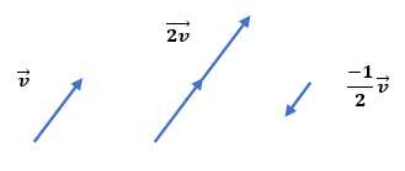
- Suppose \(\overrightarrow{u}=\left\langle -3,\left.-8\right\rangle \right.\) and \(k=3\). Then \[k\overrightarrow{u}=3\overrightarrow{u}=3\left\langle -3,\left.-8\right\rangle \right.=\left\langle 3(-3),\left.3(-8)\right\rangle \right.=\left\langle -9,\left.-24\right\rangle \right. \nonumber \]
- Suppose \(\overrightarrow{v}=\left\langle 6,\left.3\right\rangle \right.\) and \(k=\frac{-1}{3}\). Then \[k \vec{u}=\frac{-1}{3} \vec{u}=\frac{-1}{3}\langle 6,3\rangle=\left\langle\frac{-1}{3}(6), \frac{-1}{3}(3)\right\rangle=\langle-2,-1\rangle \nonumber \]
- Suppose \(\overrightarrow{u}=\left[ \begin{array}{c} -2 \\ 6 \end{array} \right]\) and \(\overrightarrow{v}=\left[ \begin{array}{c} 5 \\ 3 \end{array} \right]\). Then \[3\overrightarrow{u}+4\overrightarrow{v}=3\left[ \begin{array}{c} -2 \\ 6 \end{array} \right]+4\left[ \begin{array}{c} 5 \\ 3 \end{array} \right]=\left[ \begin{array}{c} -6 \\ 18 \end{array} \right]+\left[ \begin{array}{c} 20 \\ 12 \end{array} \right]=\left[ \begin{array}{c} 14 \\ 30 \end{array} \right] \nonumber \]
Using Technology
We can use technology to add and subtract vectors and to multiply a vector by a scalar.
Go to www.wolframalpha.com.
For the vectors \(\overrightarrow{u}=\left[ \begin{array}{c} -2 \\ 6 \end{array} \right]\) and \(\overrightarrow{v}=\left[ \begin{array}{c} 5 \\ 3 \end{array} \right]\), use WolframAlpha to find \(3\overrightarrow{u}+4\overrightarrow{v}\). Enter evaluate 3\(\mathrm{<}\)-2, 6\(\mathrm{>}\) + 4\(\mathrm{<}\)5, 3\(\mathrm{>}\) in the entry field. Wolframalpha tells you what it thinks you entered, then tells you its answer. In this case, \(<14,\ 30>\).
multiplied by 3 and <5,3> multiplied by 4. The result is the vector <14,30>." src="/@api/deki/files/97350/clipboard_eaf3e6c7b171f693605d899d7edbd53b1.png">
Try These
Find the sum of the two vectors \(\vec{u}=\langle-5,2\rangle\) and \(\vec{v}=\langle 10,-1\rangle\).
- Answer
-
\(\overrightarrow{u}\ +\ \overrightarrow{v}=\left\langle -5,\left.1\right\rangle \right.\)
Subtract the vector \(\vec{u}=\langle-5,2\rangle\) from the vector \(\vec{v}=\langle 10,-1\rangle\)
- Answer
-
\(\overrightarrow{v}-\ \overrightarrow{u}=\left\langle 15,\left.-3\right\rangle \right.\)
Suppose \(\vec{u}=\langle-5,2\rangle, \vec{v}=\langle 1,6\rangle\), and \(\vec{w}=\langle 4,-3\rangle\). Perform the operation \(2 \vec{u}-4 \vec{v}+3 \vec{w}\).
- Answer
-
\(\langle -29,-5\rangle\)

